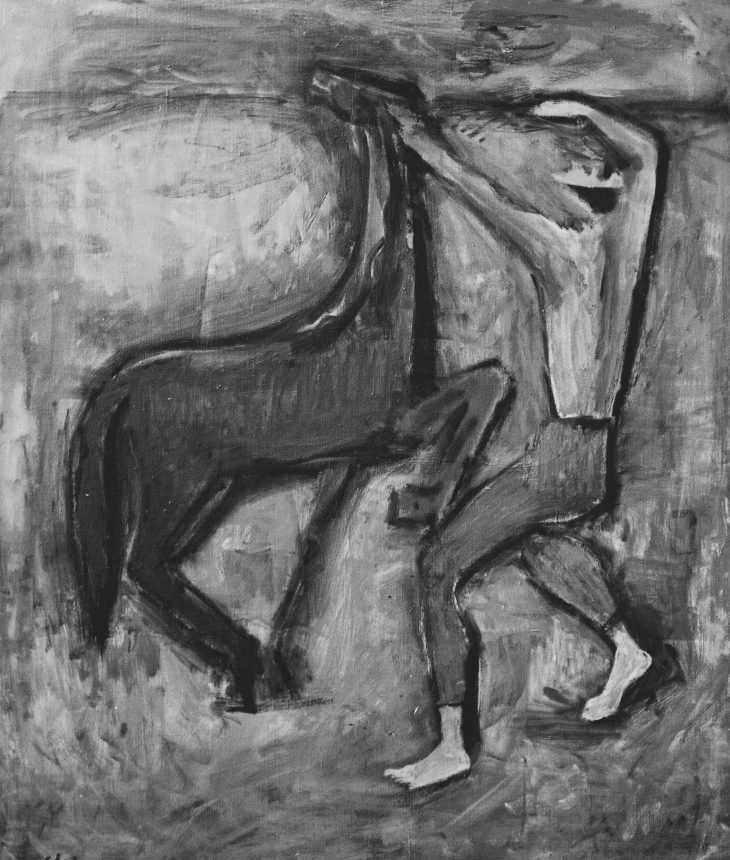Simon GLATZER
January 2, 2019Georges GOLDKORN
January 2, 2019Thomas GLEB (born Yehouda Chaïm Kalman)
LODZ (POLAND) 1912 – ANGERS (FRANCE) 1991
Thomas Gleb grew up in a family of artisans and studied at a Yeshiva. Influenced by his father, who was a weaver, he took an interest in the Bible from a young age. When he was ten years old, he used to hide and draw, and dreamed of becoming a painter. He worked as a weaver, stamp engraver, and tailor. He followed the advice of painter Aron Haber Beron and attended the Start studio in Lodz, where he drew models from life and discovered oil painting.
In 1932, he arrived in Paris and went by the name Thomas Gleb, following an article about “glebe” which was published on his painting. Since his debuts, Thomas Gleb seems to have been attracted to abstraction; however, his painting remained figurative. His childhood memories, his visits to the north of France, the coal mines, and French working life inspired his work. He worked retouching photographic portraits, and continued to paint in his free time. He met his future wife Maria at an evening class in rue de Paradis, where they were both learning French. Three years later, he designed costumes and sets for a Brussels troupe before leaving for Amsterdam.
In 1939, Gleb enlisted in the French army and then joined the Resistance. In 1944, he was arrested and imprisoned in Grenoble and in Lyon. He escaped from the train taking him to a concentration camp. In Poland, the Kalman family died in the Lodz ghetto. He painted under several pseudonyms, including Raymond Thomas. In 1945, he returned to Paris. Between 1950 and 1957, he stayed in Poland and visited Central Europe. Jean Cassou, curator at the Museum of Modern Art in Paris, visited him in his studio in Warsaw. Thomas Gleb returned to live in Paris permanently in 1957. From 1960, he discovered a new form of creation: tapestry work. His works produced before 1939 were destroyed by the Nazis.
Stories of Jewish Artists of the School of Paris 1905-1939
FRENCH-ENGLISH
Capitale des arts, le Paris des années 1905-1939 attire les artistes du monde entier. De cette période de foisonnement, un terme est resté, celui d'Ecole de Paris, qui recouvre une grande diversité d'expression artistique. Dans ce brassage dont Montparnasse est le creuset, un groupe se distingue : celui des artistes juifs venus de Russie, de Pologne et d'Europe centrale. Si leurs styles sont variés, un destin commun les rassemble : ils fuient l'antisémitisme de leur pays d'origine. Certains ont connu la célébrité dès les années 1920, tels Soutine, Lipchitz ou Chagall. D'autres n'ont pas eu le temps ou la chance d'y accéder. Près de la moitié a péri dans les camps de concentration nazis.
From 1905 to 1939, Paris attracted artists from all over the globe as the capital of the art world. This period of artistic proliferation became known as the School of Paris, and includes a great diversity of artistic expression. Within the teeming art world centred on Montparnasse, one group set itself apart: Jewish artists from Russia, Poland, and Central Europe. Although their styles were diverse, they shared the common fate of fleeing anti-Semitic persecutions in their home countries. Some became famous in the 1920s, such as Soutine, Lipchitz, and Chagall, while others did not have the time or the luck to gain renown. Nearly half of these artists died in Nazi concentration camps.





